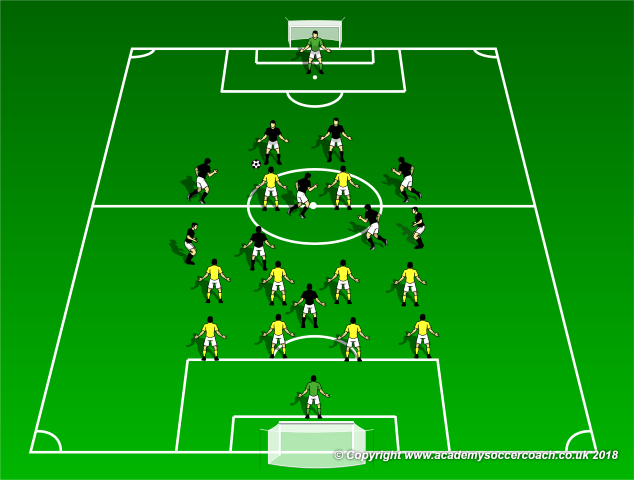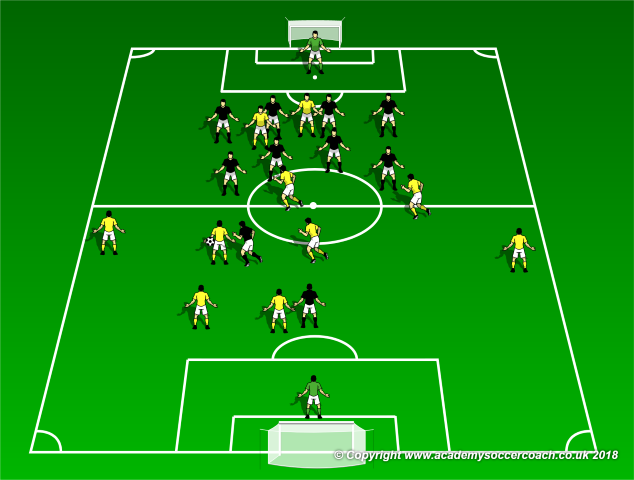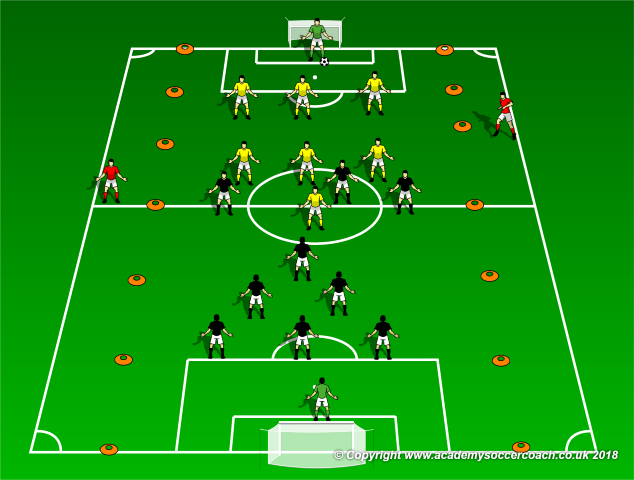By Mike Smith
I am absolutely a believer in getting the ball out wide to the flag to hit in crosses as a bread and butter style of offense. I also understand the idea of using width to make the field too big for any opponent to cover. However, what if your team just isn’t good at building out of the back and isn’t really efficient in the box when the crosses / services get there? I coached a group one time whose goals allowed total came mostly from instances where 10 seconds prior we were attacking, sent too many players into the box, didn’t win the service and gave up the counter goal with the efficiency we hoped to be attacking with. While it can go against the grain a bit, the idea of keeping your side compact in attack can work, and it does frustrate a team who wants to use the wide areas of the field and build up possession. For example:

The diagram above sets the stage for not only possession in the center of the field, but also a solid counter if the ball is lost. As shown above, the attacking team is in a 5-4-1 against a 4-4-2. In reality, this is a 9 v 6 for the attacking side. The key here is something which is lost a lot of the time when advocating for wide play. Most of the time a player who is beaten wide still has more time to recover and often times has some type of recovery angle to help. In the diagram above, if a defender steps up into the middle and is beat, the chances of recovery are poor. This is why turnovers in the middle are so devastating. A compact attack forces a good wide defender to defend more centrally and out possibly out of their comfort zone.

Again above, when the ball is turned over, even if the defending side ( yellow) gets the ball out wide, the attacking team ( black ) can recover into a solid defensive shape rather quickly. The clogged center prevents a switch through the middle and makes play either predictable up the line or slow if the yellow side chooses a long switch over the top. Also, as the diagram shows, if the far side defender gets too wide, there is a clear lane for a counter, right up the middle. This is worth working on a bit whether your team decides to try it or just needs to practice defending against it.
Set Up

As shown above, 9 attackers plus a keeper take on 7 defenders plus a keeper and two neutrals on a full field with neutral areas marked on the wings. The attacking side should attempt to play between the penalty boxes right in the center. Play starts with the defending keeper booting the ball across the half line to the attacking team, where free play begins. The yellow team may use the neutral players who have 3 seconds to serve the ball back into the fray. All players must stay in their designated zones and any balls hit out of bounds on the sides will be kicked in by the neutrals in the direction of the team the throw in would be for. Neutrals may also take corners on their side for both teams. The attacking ( black ) team may not use the neutrals directly but again, any balls played for the black team out wide should be hit in the direction of the attacking side.
Coaching Points
The focus here is the 9 v 7 in the center of the field for the attacking side. They should be able to hold the ball by making the field too long for the defenders to cover. The focus is on length and good central possession through combinations.
By Mike Smith
Currently the Head Coach for University Heights Academy Boys Soccer in Hopkinsville, KY , Mike is in his 14th year as a high school head coach with 23 years coaching experience overall and 34 year as a student and fan of the game. He holds a USSF D License.


